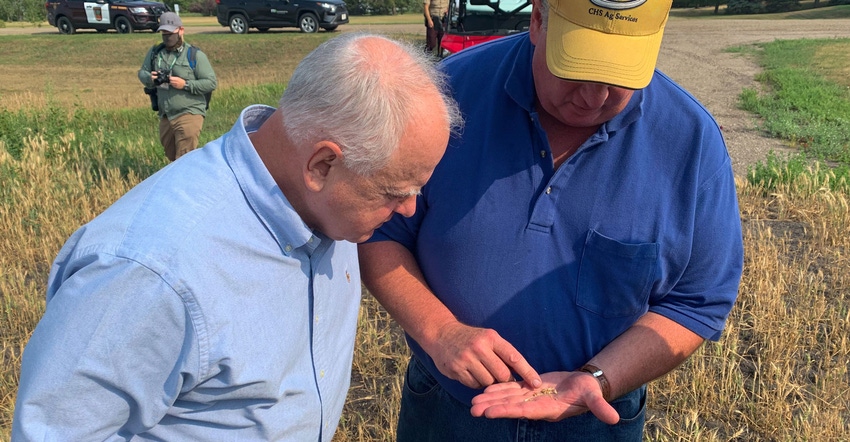July 28, 2021

Gov. Tim Walz and Minnesota agricultural commissioner Thom Petersen visited a farm in Polk County to survey the drought and discuss its impact with farmers.
The pair met with a small group of farmers on the farm of Jim and Robin Reitmeier, Crookston, to see first-hand the havoc the drought is wreaking in northwestern Minnesota.
“After a year that challenged Minnesotans across the state, our farmers are suffering yet another setback from the persistent drought,” Walz says. “This drought is threatening their livelihoods. We continue to maintain close communication with our federal partners and the agricultural community to ensure we’re providing the support and flexibility our farmers and ranchers need during this challenging time.”
D3 Extreme Drought reaches 19% of state
The U.S. Drought Monitor update released July 22 reflects a further worsening of conditions across Minnesota. Nineteen percent of the state has now reached the D3 Extreme Drought intensity, up from 4% the previous week. Seventy-two percent of the state is rated as D2 Severe Drought intensity.
A governor’s news release notes that the drought monitor update would trigger the expansion of USDA’s agriculture disaster designation to additional Minnesota counties.
Last week, Walz also spoke with USDA secretary Tom Vilsack and urged him to take action to support farmers and livestock producers.
MDA’s Rural Finance Authority Board July 14 determined that an emergency exists due to drought, making zero-interest loans available immediately for Minnesota farmers whose operations are suffering from lack of rain. The Department of Natural Resources has also convened the State Drought Task Force, a panel of state, federal, regional and local experts.
The DNR also issued a news release July 22 specifically for homeowners dealing with domestic well issues due to the drought in Polk and Red Lake counties. Increased groundwater use and the lack of groundwater recharge during the drought is making it difficult for the aquifer system to supply water to all groundwater users, leading to an increase in domestic out-of-water calls in this area.
To avoid an out-of-water situation, DNR encourages area residents to conserve water as much as possible. Ideas for indoor and outdoor water conservation are available on the DNR Water Conservation website at DNR water conservation website.
Here are DNR’s recommendations:
• Have an emergency plan for the family, bottled water handy, and the name and number of a licensed well driller.
• Be aware of changes in the well, the water from the well and the area around the well. Changes in how often the pump runs, or in the smell or color of the water, can be signs of potential problems. If your well runs out of water, call a licensed well driller at the first sign of trouble.
• If there is a high-volume water user nearby, contact that user and try to work out a solution together.
• If you are unable to restore your water supply, contact the DNR’s well interference coordinator at 651-259-5034 or the DNR area hydrologist for Polk and Red Lake counties at 218-219-8585.
Domestic well owners and municipal water suppliers that have problems obtaining water and believe the situation is due the operation of a high-capacity well that pumps in excess of 10,000 gallons per day or 1 million gallons per year can submit a Well Interference Complaint to the DNR for investigation.
Get more information on the well interference resolution process.
Source: Gov. Tim Walz’s Press Office and the Minnesota Department of Natural Resources, which are solely responsible for the information provided and is wholly owned by the source. Informa Business Media and all of its subsidiaries are not responsible for any of the content contained in this information asset. Paula Mohr contributed to this report.
You May Also Like




